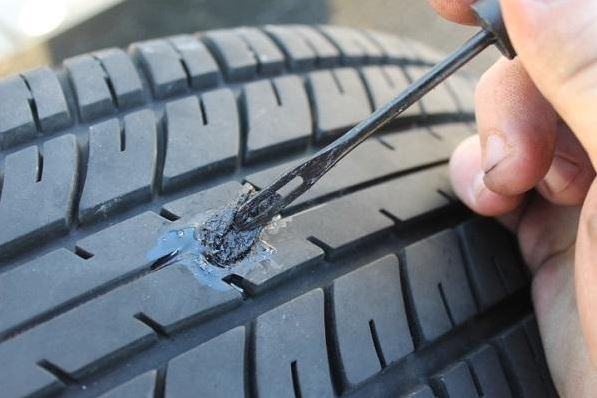One of the ways to quickly repair a punctured tire is to use a tire plug. The cord is applied to the affected area of the tire to prevent air from escaping.
One frequently asked question from car owners is how long a tire plug will last and at what speed it is safe to drive on a plugged tire.
When plugged properly, a tire plug is expected to last 25,000 miles or seven to ten years. However, it is important to highlight that plugging is a temporary solution to fixing a punctured tire before getting a replacement.
While the above estimation gives a ballpark, there is no guarantee that you won’t experience tire problems while driving on plugged tires.
In this article, I have gathered useful knowledge and answers to some of the most frequently asked questions about tire plugs.
Keep reading.
Table of Contents
How Does a Tire Plug Work?
A tire plug is made of rubber, chemical substances, and other compounds fabricated from many leather strips. When there is a puncture on your tire, the object provides a seal for the surface to prevent air leaks once inserted.
Meanwhile, it is important to consider the size and width of the puncture in a tire before plugging. Some “tire injury” requires other temporary repair approaches like patching.
Some tire plugs are more suitable for particular vehicles than others. After this is considered, inserting the plug is relatively easy, especially when you have experience fixing tire problems.
Indeed, a tire plug is no match for a new, intact tire, but it functions to prevent slow leaks, pending the time you can get a replacement.
Are Tire Plugs Safe?
Yes, a tire plug is safe and reliable in the event of a punctured tire, as long as it is installed properly and used on the right tire in the right situations. In other words, there are caveats to the safety of tire plugs.
For instance, it is generally unsafe to use tire plugs on tires that have worn out or have suffered a series of punctures.
In addition, the safety of using tire plugs also depends on the severity of the damage to the tire. Tires that have suffered a puncture on the shoulder and sidewall should not be plugged in.
If you hire a professional to plug your flat tires, you have concrete reasons to believe that it is safe and that the plugged tire will stand the test of time. However, you can still do it without a plug kit.
How To Plug A Flat Tire Safely: Step-by-step Guide
Step 1: The first step is gathering all the necessary tools for successful tire plugging. You will need tools like a lug wrench, a vehicle jack, pliers, a razor blade, an air chock, and a valve stem tool.
Step 2: Use the Jack to raise the vehicle and hold the position. The side of the vehicle that should be raised with the jack stand is the side of the affected tire. Then take the wheel lugs out of position using an impact wrench and socket.
Step 3: Remove the tire and identify the area of puncture on the tire. You can spray soapy water on the tire’s surface to spot the punctured area. The affected part will bring up bubbles.
Step 4: Remove the valve stem core using the valve stem tool and keep it around.
Step 5: The next step is to wedge a reamer into the tire hole. This will create enough room for the plug.
Step 6: First, apply a contact cement (sometimes called a lubricant) to the formed site before inserting a plug.
Step 7: Force the plug into the hole and cut off the extra plug outside the wheel using a trim.
Be careful not to slash the tread of the tire. Then twist and hand-thread the lug using a socket, so the wheel stud doesn’t cross over it.
Step 8: Use an air chock to inflate the tire and slowly remove the vehicle jack to lower the car to the ground.
Once you successfully plug your tire, you must consider some precautions, especially when driving—for example, the driving speed.
How Fast Can You Drive On A Plugged Tire?
Experts advise that you stay within 135 mph when your tire is plugged in. In other words, when you repair a flat tire, driving at a controlled speed on the highway is important.
A damaged tire already has a jeopardized structural system, which means it won’t perform as efficiently as a new one, especially in speed ratings.
Wrapping up
Tire plugging will last up to five years of usage and even more if done properly. However, you need to first consider how large the hole on the tire’s surface is and the location of the damage on the tire before using a tire plug.
While this tire repair method will last for years, it can also result in a blowout and other problems if not done correctly.
Tire plugging is also a safe repair option, but it can be dangerous if the tire has been plugged in the past.
Drive safe.

